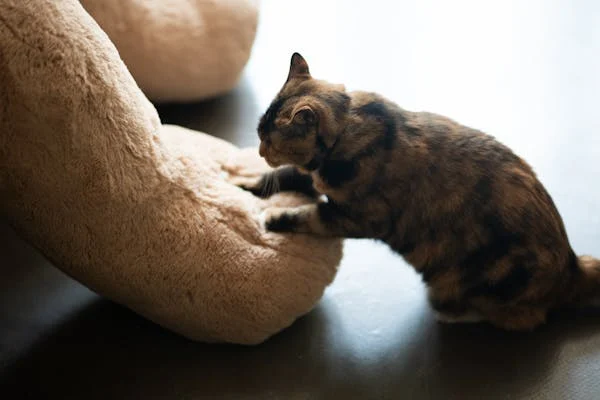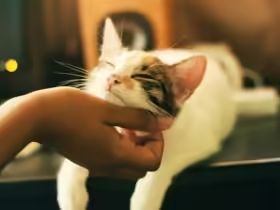If you’re a cat owner, you’ve likely experienced your feline companion pressing their paws rhythmically into your lap, a pillow, or even a soft blanket. This adorable action, known as “kneading,” often leaves cat lovers wondering, “Why do cats knead?”
The behavior may seem random, but there are actually fascinating biological and psychological reasons behind why cats knead. In this blog, we’ll dive into the science of this feline quirk, explore its origins, and understand its purpose in a cat’s life.
What Is Kneading?
Kneading is a repetitive motion where cats push their paws in and out against a soft surface, alternating between their front paws. Some cats extend their claws while kneading, while others keep them retracted. It’s common for cats to purr contentedly as they knead, especially if they are resting on their owner.
This behavior can start early in kittenhood and often persists into adulthood. While it’s generally associated with comfort and happiness, the reasons behind kneading are more complex than they might seem.
Origins of Kneading Behavior
1. Kittenhood and Nursing
One of the most widely accepted theories about why cats knead is its link to kittenhood. When kittens nurse from their mother, they knead her belly to stimulate milk flow. This instinctual motion is not only a way to get milk but also a source of comfort and security. The warmth, nourishment, and maternal connection make kneading an act of reassurance.
Even as adult cats, kneading can serve as a throwback to this early stage of life. The action is deeply embedded in a cat’s developmental history and may invoke feelings of comfort and safety when they knead, even long after they’ve been weaned.
2. Territory Marking
Cats have scent glands in their paws, so kneading may also serve as a method of territory marking. When a cat kneads, they leave behind their unique scent on the object, claiming it as their own. This behavior ties into cats’ strong territorial instincts. By kneading a favorite blanket or even a human’s lap, a cat is subtly marking its space, signaling ownership to other animals.
This territorial aspect is an important part of feline social structure. Cats rely heavily on scent to communicate, and marking their surroundings helps create a sense of safety and familiarity.
3. Stretching and Exercise
Kneading isn’t just psychological—it can be a form of stretching and exercise. Cats are naturally agile and flexible animals. When kneading, they extend and retract their paws, which helps stretch their muscles, ligaments, and tendons. This motion is especially beneficial after long periods of rest, similar to how humans stretch after waking up from a nap.
The rhythmic pushing also serves as a mild physical workout, helping to keep a cat’s muscles limber and ready for action, which is particularly important in their instinctual need to stay fit for hunting, even if they live indoors.
4. Nesting Instinct
Before cats were domesticated, their ancestors lived in the wild, where they needed to create comfortable sleeping areas. Kneading helped them pad down tall grasses or leaves to create a cozy, secure spot for sleeping. This nesting instinct has persisted in modern-day cats, even though they now enjoy the luxury of soft beds or couches.
When your cat kneads on a blanket or your lap, they may be performing this age-old instinct, creating what they perceive as a safe and comfortable resting space.
The Science Behind Kneading
1. Endorphin Release and Relaxation
Kneading may trigger the release of endorphins, which are feel-good hormones that promote relaxation and a sense of well-being. Cats are known to purr when they are kneading, which is another indicator of contentment. This combination of kneading and purring can suggest that the behavior is calming for cats, helping them de-stress after a long day of lounging or playing.
In fact, cats may knead more frequently when they are particularly happy, comfortable, or feeling affectionate towards their owner. This hormonal response is a key reason why kneading is associated with feelings of joy.
2. Evolutionary Behavior
Many behaviors in domesticated animals are remnants of their wild ancestors. In the case of cats, kneading can be traced back to behaviors exhibited by their wild relatives. Just like their big cat counterparts, such as lions and tigers, domestic cats inherit certain instincts, even if they no longer serve the same purpose.
The evolutionary significance of kneading lies in the development of comfort and survival strategies. While modern cats may no longer need to knead grass for a nest, the behavior has been retained as part of their natural instincts.
3. Connection to Feline Emotions
Kneading can also be a sign of affection. Cats often knead when they feel particularly close to their owner. If your cat kneads on your lap or chest, it’s a signal of trust and love. This behavior can be compared to the way humans seek physical contact with loved ones—kneading offers a similar emotional connection for cats.
Some researchers suggest that kneading may be a way for cats to self-soothe in stressful situations, much like how children hug a stuffed animal or blanket for comfort. The repetitive motion may create a sense of security, especially if the kneading is accompanied by purring.
Why Do Some Cats Knead with Claws?
Some cats knead with their claws extended, which can make the experience slightly painful for the person on the receiving end. While this might seem aggressive, it’s usually not intentional. When a cat is fully relaxed and comfortable, they may not be consciously aware of their claws’ extension.
Extended claws could also be linked to the stretching behavior discussed earlier. Cats use their claws to grab onto surfaces, which helps them stretch their muscles and tendons more effectively.
To make kneading more comfortable, you can keep your cat’s claws trimmed or place a thick blanket on your lap during kneading sessions.
Why Do Some Cats Not Knead?
Not all cats knead, and this variation in behavior is normal. While kneading is a common feline behavior, some cats may have outgrown the instinct or may simply express comfort in other ways. For instance, some cats might prefer to rub their faces against objects or engage in other affectionate gestures like headbutting or snuggling.
Cats also have unique personalities, and not every cat will engage in all feline behaviors. If your cat doesn’t knead, it doesn’t necessarily mean they are less affectionate or happy; they may simply have different ways of expressing contentment.
How to Respond to Your Cat’s Kneading
As a cat owner, kneading is usually a sign that your cat feels safe and happy around you. While the behavior can sometimes be uncomfortable due to sharp claws, it’s important to remember that it’s a form of bonding for your feline friend.
Here’s how to respond:
- Appreciate the Gesture – Recognize that your cat kneads because they feel comfortable and trust you. Kneading is their way of showing love and affection.
- Trim Their Nails – If your cat kneads with their claws extended, regular nail trimming can make the experience more enjoyable for both of you. You can also place a blanket or cushion between you and your cat to prevent scratches.
- Provide Soft Surfaces – Offer your cat soft blankets or cushions to knead. This will encourage them to knead in areas where they can get comfortable without causing any damage to your skin or furniture.
- Enjoy the Bonding – Kneading is a natural and affectionate behavior. Rather than discouraging it, embrace it as part of your cat’s unique way of expressing contentment and attachment.
Final Thoughts: Why Do Cats Knead?
Kneading is a fascinating and multifaceted behavior in cats. From its roots in kittenhood to its modern-day role in relaxation, territory marking, and affection, kneading is a key part of a cat’s behavior repertoire. Understanding why cats knead can help deepen the bond you share with your furry friend and offer insight into their emotional and physical needs.











Leave a Reply